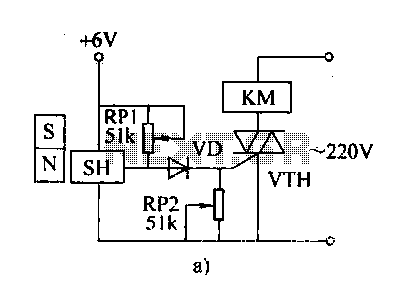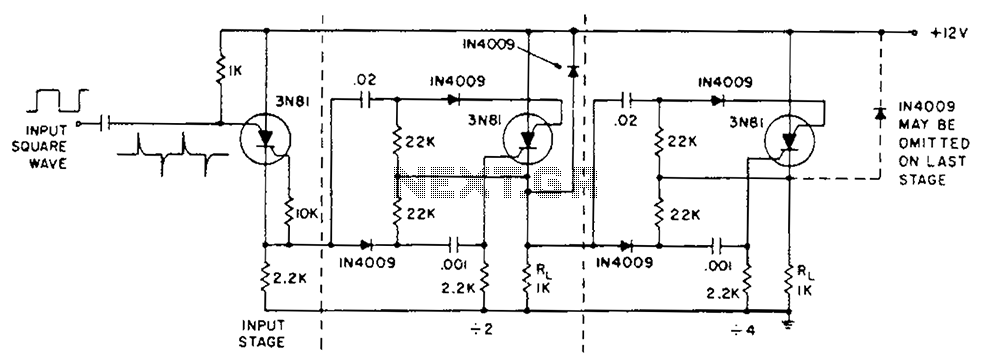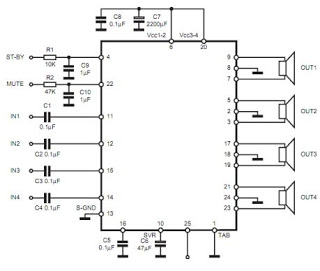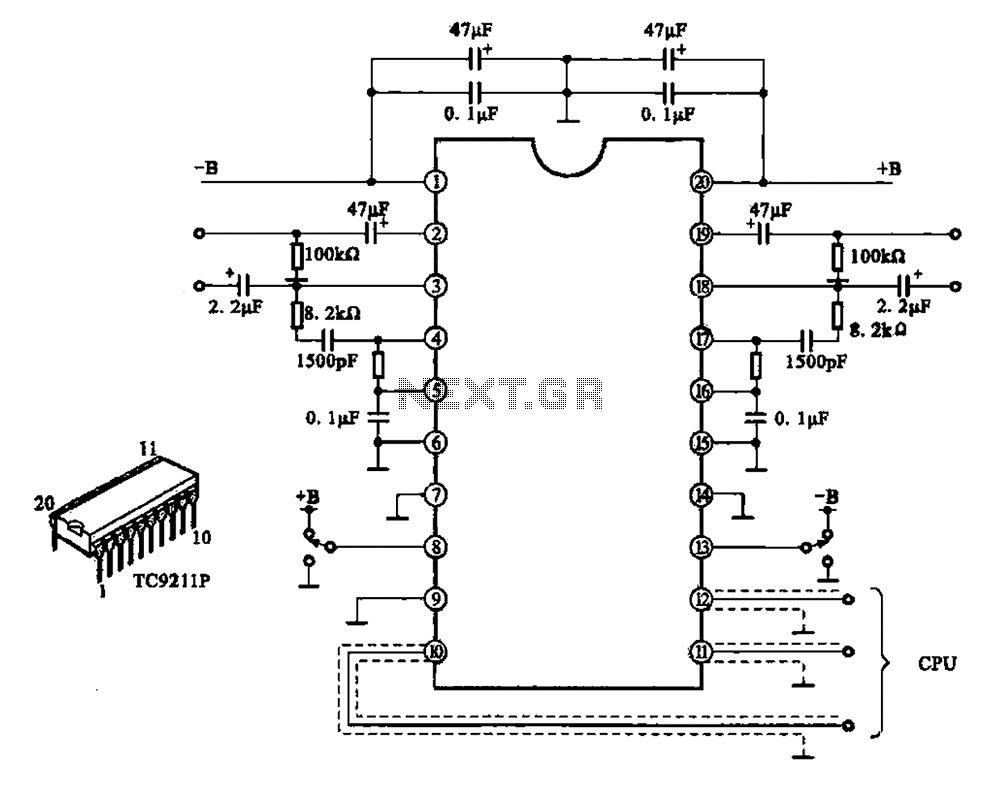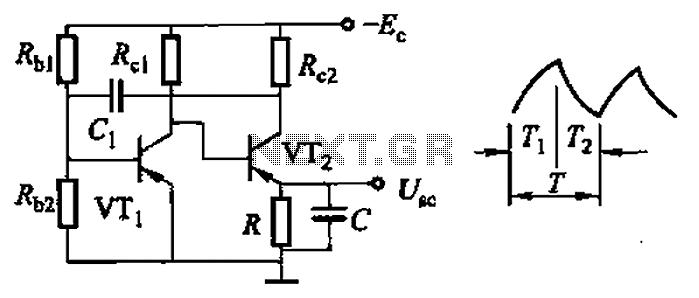
12kHz IF signal generator circuit diagram
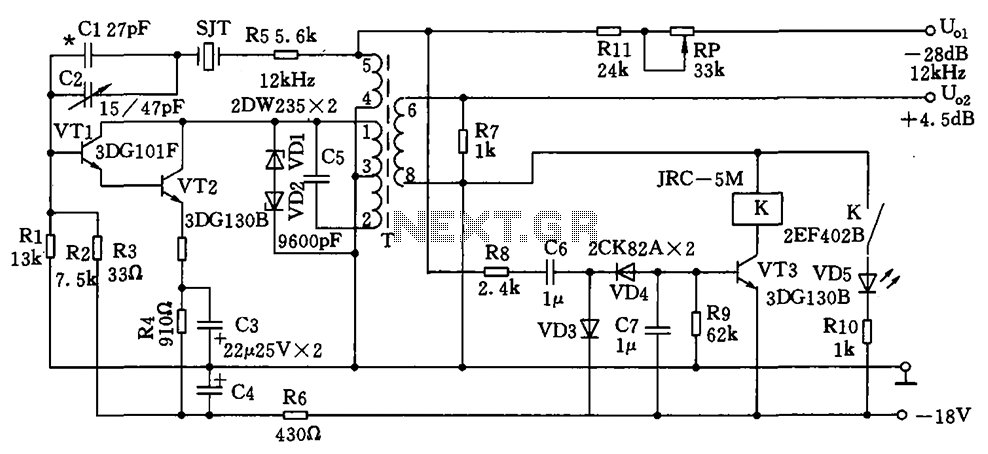
The circuit depicted is a 12 kHz intermediate frequency oscillator designed for an alarm system. It employs a variable feedback oscillation circuit where the oscillation frequency is primarily determined by a quartz crystal. Capacitors C1 and C2 are used for fine-tuning the frequency. The oscillating tube is configured to increase input impedance, while stable amplitude is achieved through bidirectional regulators VD1 and VD2.
Specifications: (1) Nominal frequency: 12 kHz, with a frequency deviation not exceeding 1 Hz; (2) Frequency accuracy: within a temperature range of 25 degrees Celsius, the deviation does not exceed 1 Hz; (3) U01 Output Level: -28 dB/600 ohms, with a deviation of less than 0.2 dB; (4) U02 Output Level: +4.5 dB, with a tolerance of 0.5 dB.
The circuit operates as a stable oscillator, utilizing a quartz crystal as the frequency-determining element. The feedback mechanism is critical for maintaining the desired oscillation frequency, which is set at 12 kHz. The inclusion of capacitors C1 and C2 allows for precise adjustments to the frequency, enabling the circuit to adapt to slight variations in component values or environmental conditions.
The use of an oscillating tube enhances the input impedance, which is essential for interfacing with subsequent stages of the alarm circuit, such as signal processing or amplification stages. The bidirectional regulators, VD1 and VD2, serve to stabilize the amplitude of the output signal, ensuring consistent performance across varying load conditions.
The specifications highlight the performance metrics of the oscillator, emphasizing its reliability and accuracy. The nominal frequency is tightly controlled, with minimal deviation, ensuring that the alarm system operates within its designed parameters. The output levels from U01 and U02 indicate the circuit's capability to interface effectively with other components in the alarm system, providing both low and high-level outputs as required for different parts of the system.
Overall, this intermediate frequency oscillator circuit is well-suited for alarm applications, delivering stable and accurate performance essential for reliable operation. Circuit as shown by the l2kHz the intermediate frequency oscillator, an alarm circuit. It uses variable feedback oscillation circuit, the oscillation frequency is mainly determ ined by a quartz crystal. Cl, C2 can fine-tune the frequency. Oscillating tube composite pipe to increase input impedance, stable amplitude by VDl, VD2 bidirectional regulator obtained.Specifications: (1) Nominal frequency: 12kHz, the frequency difference does not exceed 1Hz; (2) frequency accuracy: in the temperature range of 25 25, F does not exceed lHz; (3) U01 Output Level: -28dB/600, deviation of less than 0.2dB; (4) U02 Output Level: + 4.5dB 0.5dB.
Specifications: (1) Nominal frequency: 12 kHz, with a frequency deviation not exceeding 1 Hz; (2) Frequency accuracy: within a temperature range of 25 degrees Celsius, the deviation does not exceed 1 Hz; (3) U01 Output Level: -28 dB/600 ohms, with a deviation of less than 0.2 dB; (4) U02 Output Level: +4.5 dB, with a tolerance of 0.5 dB.
The circuit operates as a stable oscillator, utilizing a quartz crystal as the frequency-determining element. The feedback mechanism is critical for maintaining the desired oscillation frequency, which is set at 12 kHz. The inclusion of capacitors C1 and C2 allows for precise adjustments to the frequency, enabling the circuit to adapt to slight variations in component values or environmental conditions.
The use of an oscillating tube enhances the input impedance, which is essential for interfacing with subsequent stages of the alarm circuit, such as signal processing or amplification stages. The bidirectional regulators, VD1 and VD2, serve to stabilize the amplitude of the output signal, ensuring consistent performance across varying load conditions.
The specifications highlight the performance metrics of the oscillator, emphasizing its reliability and accuracy. The nominal frequency is tightly controlled, with minimal deviation, ensuring that the alarm system operates within its designed parameters. The output levels from U01 and U02 indicate the circuit's capability to interface effectively with other components in the alarm system, providing both low and high-level outputs as required for different parts of the system.
Overall, this intermediate frequency oscillator circuit is well-suited for alarm applications, delivering stable and accurate performance essential for reliable operation. Circuit as shown by the l2kHz the intermediate frequency oscillator, an alarm circuit. It uses variable feedback oscillation circuit, the oscillation frequency is mainly determ ined by a quartz crystal. Cl, C2 can fine-tune the frequency. Oscillating tube composite pipe to increase input impedance, stable amplitude by VDl, VD2 bidirectional regulator obtained.Specifications: (1) Nominal frequency: 12kHz, the frequency difference does not exceed 1Hz; (2) frequency accuracy: in the temperature range of 25 25, F does not exceed lHz; (3) U01 Output Level: -28dB/600, deviation of less than 0.2dB; (4) U02 Output Level: + 4.5dB 0.5dB.
